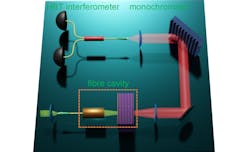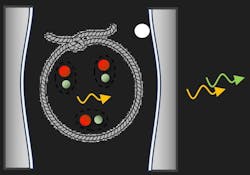Quantum optics technique reveals new type of light-matter interaction within semiconductors
A quantum optics technique developed by a team of scientists led by Macquarie University’s Professor Thomas Volz in Australia can provide unprecedented access to the fundamental properties of light-matter interactions within semiconductors (see video). Exploring how minute light particles interact reveals valuable insights into the quantum properties of solid materials, such as semiconductors.
The team’s spectroscopic technique uses a radiative quantum cascade, in which photons stored in a material travel down a ladder of energy levels generated when light and matter interact, and it has the potential to spur breakthroughs in the quest for accessible quantum photonics technologies.
“Quantum cascade describes the emission of consecutive photons from a ladder of energy levels,” explains Volz. “Typically, such consecutive emission of photons occurs when an atom is highly excited and emits subsequent photons—one after the other. In the case of atoms, photons typically have clearly distinct colors and it’s easy to separate them. Detecting the photons then directly gives information about the atoms.”
Photons are emitted from a semiconductor system and are very close in energy, so the team uses a narrowband optical filter to distinguish them. And they can also detect their order in time/whether they’re emitted in pairs, which reveals important information about the underlying system.
“A word about polaritons: Thinking of semiconductors, people normally assume electron-hole pairs (or excitons),” says Volz. “But, in our case, we couple electron hole pairs to light within an optical cavity, forming new (quasi) particles called polaritons. They’re literally half matter/light particles that can collide with each other due to interactions.”
Coupling photons to electron-hole pairs is a way to make particles of light strongly interact with each other. Ultimately, it could enable building a transistor for single photons, and researchers might be able to perform computations with photons (polaritons) rather than electrons—but polaritons are still somewhat of an abstract concept.
The team’s method is incredibly sensitive and can reveal important information about the underlying semiconductor system. “At the same time, the method is comparatively simple to implement and should be applicable to a range of different optically active semiconductor platforms,” says Volz.
Radiative quantum cascade setup
The team’s setup (see Fig. 1) involves an optical microcavity made by two mirrors, where they insert an optically active material—a material that can absorb light—to generate polaritons.
“Light transmitted through the cavity is first sent to a very narrow spectral filter,” says Lorenzo Scarpelli, a former postdoctoral fellow at Macquarie University and now a postdoctoral researcher at Delft University of Technology in the Netherlands. “This is made by a spectrometer, where a diffraction grating disperses different light frequencies into different directions. We then use a big lens to collect all these frequencies and focus them onto a very small region of space behind the lens—but in a way that each frequency has a slightly different position.”
Next, they place an optical fiber, which transmits only the frequencies of where the fiber is located and it creates a spectral filter. “The transmitted frequencies, which couple to the fiber, are split using a fiber beamsplitter—which sends 50% of the light to a superconducting single-photon detector and the other 50% to a second identical detector,” Scarpelli adds. “And then we can study the correlation between the arrival time of the different photons as a function of the filter frequency.”
For Scarpelli, the coolest thing about this technique is that it’s relatively easy to set up and at the same time gives you the possibility to investigate light-matter interactions at the level of the single particles of light. “If you think about what’s happening, it’s crazy how well this technique works—it came as a big and pleasant surprise,” he says.
Feshbach resonances
The most surprising aspect of the team’s work is that their new technique enabled them to detect complex bound states of excitons (electron-hole pairs) that are associated with Feshbach resonances for polaritons—a concept well known and exploited in atomic physics.
“Feshbach resonances strongly modulate the strength with which particle interact and, in our case, the interaction between polaritons is strongly modified,” says Volz. “While two-body Feshbach resonances (involving two bound excitons) have been demonstrated before, our technique shows for the first time a three-body Feshbach resonance for polaritons (involving three bound excitons).” (See Fig. 2.)
For a while, the team couldn’t wrap their heads around the experimental data they obtained. “We didn’t have the Feshbach resonances on our radar and simply expected a monotonic behavior of the polariton interactions,” Volz explains. “Simply put: as the energy difference between the photons and the electron-hole pairs that make up the polaritons changes, the strength with which the polaritons interact should change.”
The more photon-like the polariton, the weaker the interactions—photons in vacuum, without the semiconductor, don’t interact at all.
“Our measurements revealed a completely nonmonotonic behavior,” says Volz. “For a long time, we kept checking all the settings of the experiment, thought we had done something wrong, and couldn’t make sense of the data we got at all. Even when we realized that Feshbach resonances played a role, the data at first didn’t match our theoretical expectations. Finally, when reading the existing polariton literature again, we realized that there could be a three-body Feshbach resonance playing a role and everything made sense!”
Light-matter interactions
The team’s work will be useful for fundamental studies of semiconductor material platforms. “Our method can directly reveal interactions between polaritons—an important quantity that’s difficult to directly measure otherwise,” says Volz. “It might also be possible to apply the method for studying complex many-body states in other platforms, but this will certainly require some more specific modeling in each case.”
What does this new tool mean for quantum optics? “It’s certainly an important tool that can be helpful in understanding the fundamentals of light-matter interaction,” says Scarpelli. “Our experiments were performed on gallium arsenide (GaAs), but the technique can be applied to a wide range of optically active materials. Although polaritons in GaAs have been studied for many years, with our new technique we observed a specific type of interaction that was only theorized before—so hopefully it’ll also give new insights into other materials.”
The researchers plan to continue their quest for a material that can lead to super strong interactions between single photons—and ultimately achieve the dream of a single-photon transistor. “My research group is now working on Rydberg polaritons in copper oxides and we hope to repeat the measurements from our work in that new material system,” Volz says.
Volz is currently on an industry secondment in Germany, working for a startup in Munich that aims to build an optical quantum computer, and will be on leave from his academic job for a few years.
FURTHER READING
L. Scarpelli et al., Nat. Phys., 20, 214–218 (2024); https://doi.org/10.1038/s41567-023-02322-x.
About the Author
Sally Cole Johnson
Editor in Chief
Sally Cole Johnson, Laser Focus World’s editor in chief, is a science and technology journalist who specializes in physics and semiconductors.


